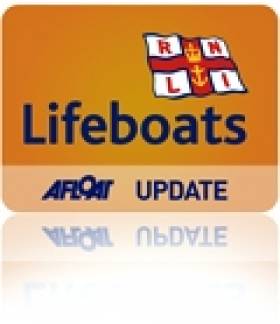Displaying items by tag: Bundoran
Bundoran RNLI Pushes the Boat Out
The boat push will start on Donegal Road in Ballyshannon at noon and members of the lifeboat crew will have buckets with them on the route for people to make a donation.
The fundraising drive comes as Bundoran RNLI recently received a new state of the art Atlantic 85 lifeboat. The new lifeboat can carry a fourth crewmember and has more room for casualties. It can also reach speeds of up to 35 knots in responding to an emergency.
Commenting on the fundraiser, lifeboat press officer Colm Hamrogue said, "The lifeboat crew wanted to do something a bit different to raise funds for the station. Many people have done a bed push but not too many people have done a boat push, which makes sense for a lifeboat station. Our volunteer crew count on the generous support of the public to ensure that the RNLI can continue to provide all year search and rescue coverage and we hope to get lots of support on Saturday."
Related Safety posts
RNLI Lifeboats in Ireland
Safety News
Rescue News from RNLI Lifeboats in Ireland
Coast Guard News from Ireland
Water Safety News from Ireland
Marine Casualty Investigation Board News
Marine Warnings
Bundoran RNLI Lifeboat Has a Busy Day with Two Callouts.
Bundoran RNLI lifeboat was called out twice yesterday (Tuesday, 27 July) to two individual callouts in Bundoran, Co. Donegal. The first call out was to three children off the main beach in Bundoran. Two of the children had been taken to shore by local beach lifeguards and the lifeboat brought the third child to shore safety. The three children received first aid and oxygen and then were taken to Sligo General Hospital by ambulance. They were three children from the one family on holiday in Bundoran from Co. Down.
The second callout was to two adults in their mid twenties who were walking on the famous “Rougey Walk” and stepped off the walk, on to the rocks at the Fairy Bridges and with the large swell in the waves, the two persons got into difficulties with their dog. The lifeboat crew assisted the two persons to get back to safe ground on the shore.
Commenting after the callouts, Colm Hamrogue, Press Officer, Bundoran RNLI Lifeboat said, “Thankfully everyone was rescued safely today. It is very important to be fully aware of your surrounding when enjoying sea for the rest of the summer. When you are on the shore and you see something you are not sure of, please do not hesitating in calling the RNLI Lifeboat on 112. It is better to be safe than sorry as we want everyone to have a safe and happy summer.
Related Safety posts
RNLI Lifeboats in Ireland
Safety News
Rescue News from RNLI Lifeboats in Ireland
Coast Guard News from Ireland
Water Safety News from Ireland
Marine Casualty Investigation Board News
Marine Warnings
























